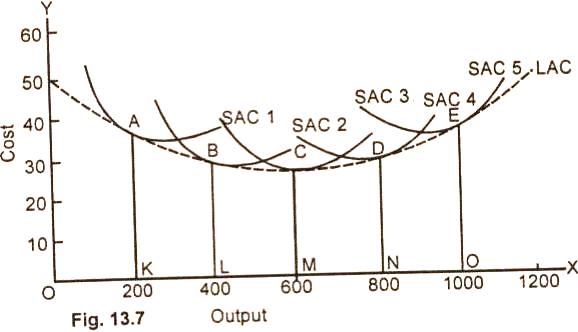Short Run and Long Run
Average Cost Curves:
Relationship and Difference:
Short Run Average Cost Curve:
In the
short run, the shape of the average total cost curve (ATC)
is U-shaped. The, short run
average cost curve
falls in the beginning, reaches a minimum and then begins to
rise. The reasons for the average cost to fall in the beginning
of production are that the fixed factors of a firm remain the
same. The change only takes place in the variable factors such
as raw material, labor, etc.
As the fixed cost gets distributed
over the output as production is expanded, the average cost,
therefore, begins to fall. When a firm fully utilizes its scale
of operation (plant size), the average cost is then at its
minimum. The firm is then operating to its optimum capacity. If
a firm in the short-run increases its level of output with the
same fixed plant; the economies of that scale of production
change into diseconomies and the average cost then begins to
rise sharply.
Long Run
Average Cost Curve:
In the
long run, all costs of a firm are variable. The factors of
production can be used in varying proportions to deal with an
increased output. The firm having time-period long enough can
build larger scale or type of plant to produce the anticipated
output. The shape of the long run average cost curve is
also U-shaped but is flatter that the short run curve as is
illustrated in the following diagram:
Diagram/Figure:

In the diagram 13.7 given above,
there are five alternative scales of plant SAC1 SAC2,
SAC3, SAC4 and, SAC5. In the
long run, the firm will operate the scale of plant which is most
profitable to it.
For example, if the anticipated rate of output
is 200 units per unit of time, the firm will choose the smallest
plant It will build the scale of plant given by SAC1
and operate it at point A. This is because of the fact that at
the output of 200 units, the cost per unit is lowest with the
plant size 1 which is the smallest of all the four plants. In
case, the volume of sales expands to 400, units, the size of the
plant will be increased and the desired output will be attained
by the scale of plant represented by SAC2 at point B,
If the anticipated output rate is 600 units, the firm will build
the size of plant given by SAC3 and operate it at
point C where the average cost is $26 and also the lowest The
optimum output of the firm is obtained at point C on the medium
size plant SAC3.
If the anticipated output rate is
1000 per unit of time the firm would build the scale of plant
given by SAC5 and operate it at point E. If we draw a
tangent to each of the short run cost curves, we get the long
average cost (LAC) curve. The LAC is U-shaped but is flatter
than tile short run cost curves. Mathematically expressed, the
long-run average cost curve is the envelope of the SAC curves.
In this figure 13.7, the long-run
average cost curve of the firm is lowest at point C. CM is the
minimum cost at which optimum output OM can be, obtained.
Relevant Articles:
|